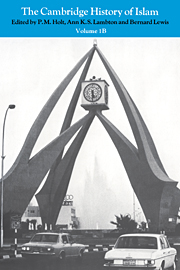Book contents
- Frontmatter
- Introduction
- Part IV The central Islamic lands in recent times
- 1 Modern Turkey
- 2 The Arab lands
- 3 Modern Persia
- 4 Islam in the Soviet Union
- 5 Communism in the central Islamic lands
- 6 The Political impact of the West
- 7 Economic and social change
- Dynastic lists
- Bibliography
- Glossary
- Index
- References
3 - Modern Persia
from Part IV - The central Islamic lands in recent times
Published online by Cambridge University Press: 28 March 2008
- Frontmatter
- Introduction
- Part IV The central Islamic lands in recent times
- 1 Modern Turkey
- 2 The Arab lands
- 3 Modern Persia
- 4 Islam in the Soviet Union
- 5 Communism in the central Islamic lands
- 6 The Political impact of the West
- 7 Economic and social change
- Dynastic lists
- Bibliography
- Glossary
- Index
- References
Summary
Political developments: 1906–47
On 30 December 1906, the Qājār monarch Muaffar al-Dīn Shāh signed the fundamental law (qānūn-i asāsī). By his signature of this instrument, the shah in theory converted Persia from a traditional Islamic society to a constitutional monarchy. The fundamental law provided for the establishment of a National Consultative Assembly (Majlis-i shawrā-yi Millī), which actually met for the first time on 7 October 1906, prior to the signature of the fundamental law by the shah, and of an upper house or Senate, which was not called into being until 1950. The instrument of the constitution was completed by the ratification by Muhammad ‘Alī Shāh, on 7 October 1907, of the supplementary fundamental law. This dealt with the rights of the Persian people and of the members of the National Consultative Assembly, and defined the powers of the crown, ministers, judicial tribunals and the army. The real dividing-line between traditional Persia and modern Iran, however, is not 1906, but 1921 when Riżā Khān (later Riżā Shāh Pahlavī) came to power by a coup d'état. The promulgation of the constitution was, of course, an important step forward, but for a variety of reasons it did not fulfil the hopes of the constitutionalists, and did not lead immediately to the remodelling of Persian political, economic and social life along Western lines. The measures introduced by Riżā Shāh, on the other hand, represented a definite break with the traditional past. It was he who launched Persia into the twentieth century.
- Type
- Chapter
- Information
- The Cambridge History of Islam , pp. 595 - 626Publisher: Cambridge University PressPrint publication year: 1977



